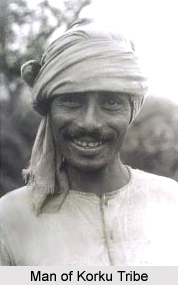 Culture of Khandwa (East Nimar) district is greatly diverse with people belonging to different communities live in this district. However, there is unity in this huge diversity, people live in this district with mutual harmony, and they celebrate each other`s festival with equal enthusiasm. Major part of population is Hindus, Muslims, Sikhs and Sindhis. Hindus form about 80 percent of the total population of this district of Madhya Pradesh. Mainly Rajputs, Kunbi tribe, Gujjars, and Marathas form the agricultural social structure and construct the rural mass. The Bania Community, Jains, Muslims, Sikhs and Sindhis, mainly prefer to stay in urban areas. They comprise the trade oriented non-agricultural social structure. The Korkus, the Gond tribe and the Bhils are major scheduled tribes, which live in the forest areas.
Culture of Khandwa (East Nimar) district is greatly diverse with people belonging to different communities live in this district. However, there is unity in this huge diversity, people live in this district with mutual harmony, and they celebrate each other`s festival with equal enthusiasm. Major part of population is Hindus, Muslims, Sikhs and Sindhis. Hindus form about 80 percent of the total population of this district of Madhya Pradesh. Mainly Rajputs, Kunbi tribe, Gujjars, and Marathas form the agricultural social structure and construct the rural mass. The Bania Community, Jains, Muslims, Sikhs and Sindhis, mainly prefer to stay in urban areas. They comprise the trade oriented non-agricultural social structure. The Korkus, the Gond tribe and the Bhils are major scheduled tribes, which live in the forest areas.
Hindi language is a common medium of communication in the urban areas of the Khandwa (East Nimar) district. Nimadi language is spoken in the rural area of North-West portions of the district whereas Bhili language is the mode of communication for the Korku tribe. Northern part of this district comprises of Malvi language and Korku speaking mass in the non-tribal and tribal areas respectively. Gujarati languageand Rajasthani language are also spoken in several social circles, like Bohra community and many other tribal communities in that area. Major part of the working people is in the primary sector of agriculture. The average farm size per family is low and the adoption of traditional form of agriculture has helped the majority of peasants to earn their livelihood only. Agricultural labourers form a sizable portion of the total population.
People of this district also follow a peaceful communal life. Mandhata is a well-known pilgrim centre in the Khandwa (East Nimar) district. Throughout the year, a number of pilgrims from distant parts of the country visit the place. In the month of Kartika, a fair is held at this place; attend by a large number of pilgrims. About 40 fairs are held in this district. "Yatras" or Operas are held at Brahmagir Maharaja`s fair at Sivna. Daata-Saheb`s fair at Malegaon, Bageshwari Devi`s fair at Borgaon, Baba Bukhardas`s fair at Chhanera, Kajal Devi`s fair at Punasa, Shivaratri`s fairs at Rustampur etc are the fairs hold every year. There are other fairs like Suktakhurd, Nimbola, Sival, Khaknar, Dongergaon fair in the name of Lord Rama at Jamaniya and in the name of Lord Hanuman at Barziri, Ukhadgaon, Mohangarh.
The rich heritage of communal dances is still preserved by the Rajputs, Korkus, Gujjars, Nagar Brahmins and Banjara Tribe. The Rajput male dance is known as Kimadi and Gair dance while their female-folk is called Khada. Among the Gujjars, the male folk perform dip dance. The male dance of Korkus is Susur, whereas Gadolia is female-folk of the same. The female folk dance of the Gujarati community is known as Garba while the Nimar`s famous folk dance is Kathi. Gammat and Ramlila are the much-loved pastimes of the rural mass of this district in Madhya Pradesh.






